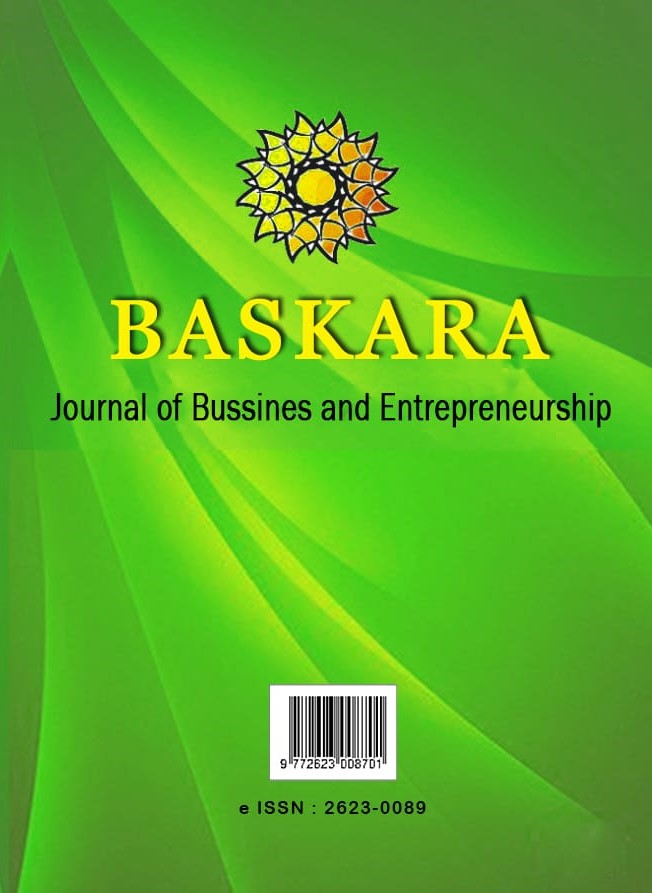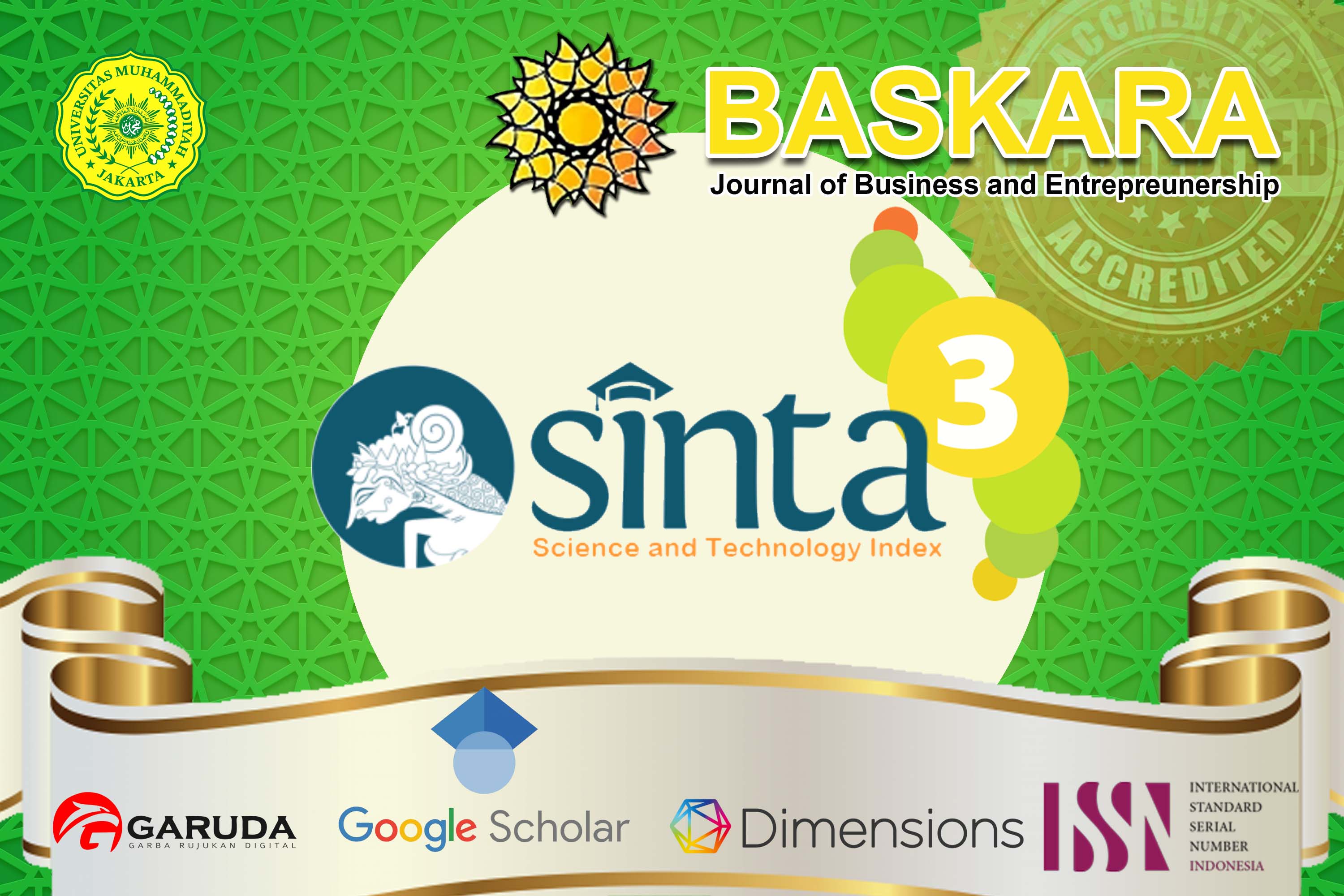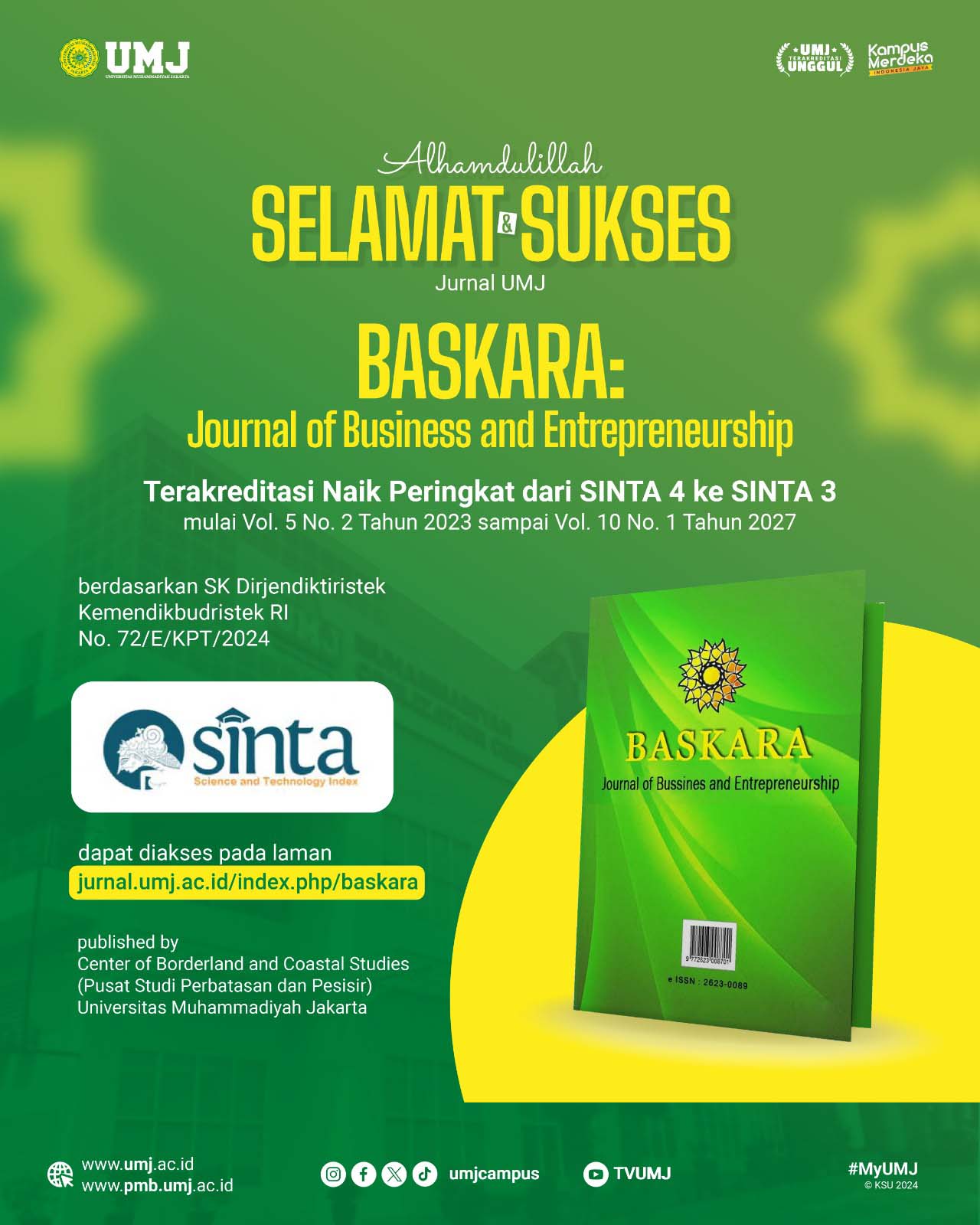Individual Cultural Values and Profit Expectations on Investment Intentions in Crypto Currency: Religiosity as a Moderating Variable
DOI:
https://doi.org/10.54268/baskara.v6i1.18657Keywords:
Individual cultural values, Profit expectancy, investment intention, CryptocurrencyAbstract
This study intends to investigate the effects of conscious and unconscious processes on crypocurrency investment intention. The impact of personal cultural values, profit expectations, and religiosity on intentions for hazardous investments was examined within this paradigm. Additionally, the mediating function of profit expectations in the association between a person's cultural values and religion for crypocurrency investment intents was also examined. Additionally, the topic of religion as a mediator of profit expectations and crypocurrency investing purpose was covered. When our graduate students willingly shared the online survey link on their social networks between February and July 2022, the data were gathered. In all, 446 people responded to the questionnaire in this manner. The AMOS programme was used to carry out structural equation modelling (SEM), which was used to test the research model.In addition to these, the effects of age, education level, sex, and marital status on individual cultural values and investment intentions were examined. The age group of 41 to 50 years old had the highest uncertainty avoidance level. People above the age of 41 had the highest level of long-term orientation. The 51-year-old age group had the least risky investing objectives. Age did not influence collectivism or power distance. The amount of schooling had no impact on any variations in the pertinent variables. Intention to take risks, power distance, masculinity, and collectivism are all greater in men than in women, and married people are more likely to avoid uncertainty and to identify as men than unmarried people. This study is the first to examine the combined effect of conscious and unconscious processes on cryptocurrency investing intentions. The authors have also offered evidence for the presence of a link between these three factors. On the other hand, the number of empirical studies examining the relationship between profit expectancy, religion, and investment intention in cryptocurrency is rather small.References
Akhtar, F., & Das, N. (2019). Predictors of investment intention in Indian stock markets: Extending the theory of planned behaviour. International Journal of Bank Marketing, 37(1), 97–119. https://doi.org/10.1108/IJBM-08-2017-0167
Al-Okaily, M., Alalwan, A. A., Al-Fraihat, D., Alkhwaldi, A. F., Rehman, S. U., & Al-Okaily, A. (2022). Investigating antecedents of mobile payment systems’ decision-making: a mediated model. Global Knowledge, Memory and Communication. https://doi.org/10.1108/GKMC-10-2021-0171
Ali, M., Raza, S. A., Khamis, B., Puah, C. H., & Amin, H. (2021). How perceived risk, benefit and trust determine user Fintech adoption: a new dimension for Islamic finance. Foresight, 23(4), 403–420. https://doi.org/10.1108/FS-09-2020-0095
Alipour, A. (2019). The conceptual difference really matters: Hofstede vs GLOBE’s uncertainty avoidance and the risk-taking behavior of firms. Cross Cultural and Strategic Management, 26(4), 467–489. https://doi.org/10.1108/CCSM-04-2019-0084
Alipour, A. (2021). What matters for the future? Comparing Globe’s future orientation with Hofstede’s long-term orientation. Cross Cultural and Strategic Management, 28(4), 734–759. https://doi.org/10.1108/CCSM-08-2020-0163
Aren, S., & Nayman Hamamci, H. (2020). Relationship between risk aversion, risky investment intention, investment choices: Impact of personality traits and emotion. Kybernetes, 49(11), 2651–2682. https://doi.org/10.1108/K-07-2019-0455
Bakar, N. A., & Rosbi, S. (2018). Robust Framework Diagnostics of Blockchain for Bitcoin Transaction System: A Technical Analysis from Islamic Financial Technology (i-FinTech) Perspective. International Journal of Business and Management, 2(3), 22–29. https://doi.org/10.26666/rmp.ijbm.2018.3.4
Baker, H. K., Kumar, S., Goyal, N., & Gaur, V. (2019). How financial literacy and demographic variables relate to behavioral biases. Managerial Finance, 45(1), 124–146. https://doi.org/10.1108/MF-01-2018-0003
Bolomope, M., Amidu, A. R., Filippova, O., & Levy, D. (2021). Property investment decision-making behaviour amidst market disruptions: an institutional perspective. Property Management, 39(1), 1–21. https://doi.org/10.1108/PM-06-2020-0042
Caron, F. (2019). Obtaining reasonable assurance on cyber resilience. Managerial Auditing Journal. https://doi.org/10.1108/MAJ-11-2017-1690
Castro, E., Hassan, M. K., Rubio, J. F., & Halim, Z. A. (2020). Relative performance of religious and ethical investment funds. Journal of Islamic Accounting and Business Research, 11(6), 1227–1244. https://doi.org/10.1108/JIABR-04-2019-0084
Comizio, V. G., Dayanim, B., & Bain, L. (2016). Cybersecurity as a global concern in need of global solutions: an overview of financial regulatory developments in 2015. Journal of Investment Compliance, 17(1), 101–111. https://doi.org/10.1108/joic-01-2016-0003
Coutelle-Brillet, P., Riviere, A., & des Garets, V. (2014). Perceived value of service innovation: A conceptual framework. Journal of Business and Industrial Marketing, 29(2), 164–172. https://doi.org/10.1108/JBIM-04-2012-0066
Deb, M. (2018). Store attributes, relationship investment, culture, religiosity and relationship quality: A cross-cultural study. International Journal of Retail and Distribution Management, 46(7), 615–637. https://doi.org/10.1108/IJRDM-10-2017-0225
Dhali, M., & Hassan, S. (2023). Cryptocurrency in the Darknet : sustainability of the current national legislation. International Journal of Law and Management, 65(3), 261–282. https://doi.org/10.1108/IJLMA-09-2022-0206
Dinç Aydemir, S., & Aren, S. (2017). Do the effects of individual factors on financial risk-taking behavior diversify with financial literacy? Kybernetes, 46(10), 1706–1734. https://doi.org/10.1108/K-10-2016-0281
Farooq, U., Jibran Qamar, M. A., & Haque, A. (2018). A three-stage dynamic model of financial distress. Managerial Finance, 44(9), 1101–1116. https://doi.org/10.1108/MF-07-2017-0244
Gill, A., Mand, H. S., Biger, N., & Mathur, N. (2018). Influence of religious beliefs and spirituality on decision to insure. International Journal of Emerging Markets, 13(5), 780–800. https://doi.org/10.1108/IJoEM-07-2017-0235
Gill, A., & Mathur, N. (2018). Religious beliefs and the promotion of socially responsible entrepreneurship in the Indian agribusiness industry. Journal of Agribusiness in Developing and Emerging Economies, 8(1), 201–218. https://doi.org/10.1108/JADEE-09-2015-0045
Haapamäki, E., & Sihvonen, J. (2019). Cybersecurity in accounting research. Managerial Auditing Journal, 34(7), 808–834. https://doi.org/10.1108/maj-09-2018-2004
Hanini, M. W. (2020). The feasibility of investment in the religious heritage in anti-corruption efforts in Palestinian public organizations. Journal of Money Laundering Control, 24(1), 29–48. https://doi.org/10.1108/JMLC-06-2020-0071
Haq, F. M. (2014). The significance of partnership as a marketing strategy for Islamic spiritual tourism. Journal of Islamic Marketing, 5(2), 258–272. https://doi.org/10.1108/JIMA-11-2013-0079
Hoffmann, A. O. I., & Post, T. (2017). How return and risk experiences shape investor beliefs and preferences. Accounting and Finance, 57(3), 759–788. https://doi.org/10.1111/acfi.12169
Juisin, H. A., Mohd Sayuthi, M. A. S., Amin, H., & Shaikh, I. M. (2023). Determinants of Shari’ah gold investment behaviour: the case of Penang, Malaysia. Journal of Islamic Marketing, July 2001. https://doi.org/10.1108/JIMA-11-2021-0360
Junarsin, E., Hanafi, M. M., Iman, N., Arief, U., Naufa, A. M., Mahastanti, L., & Kristanto, J. (2023). Can technological innovation spur economic development? The case of Indonesia. Journal of Science and Technology Policy Management, 14(1), 25–52. https://doi.org/10.1108/JSTPM-12-2020-0169
Khan, M. T. I., Tan, S. H., & Chong, L. L. (2017). Perception of past portfolio returns, optimism and financial decisions. Review of Behavioral Finance, 9(1), 79–98. https://doi.org/10.1108/RBF-02-2016-0005
Khan, R., & Hakami, T. A. (2022). Cryptocurrency : usability perspective versus volatility threat. Journal of Money and Business, 2(1), 16–28. https://doi.org/10.1108/JMB-11-2021-0051
Khlif, H. (2016). Hofstede’s cultural dimensions in accounting research: A review. Meditari Accountancy Research, 24(4), 545–573. https://doi.org/10.1108/MEDAR-02-2016-0041
Kurt, Y., Sinkovics, N., Sinkovics, R. R., & Yamin, M. (2020). The role of spirituality in Islamic business networks: The case of internationalizing Turkish SMEs. Journal of World Business, 55(1), 101034. https://doi.org/10.1016/j.jwb.2019.101034
Laba, A. R., Amar, M. Y., & Rahim, F. R. (2022). Financial Literacy , Financial Technology and Saving Behavior. 1st Proceedings of the International Conference on Economics and Business, 1(2), 463–473.
Lam, W. (2010). Funding gap, what funding gap? Financial bootstrapping: Supply, demand and creation of entrepreneurial finance. International Journal of Entrepreneurial Behaviour & Research, 16(4), 268–295. https://doi.org/10.1108/13552551011054480
Lawhaishy, Z. B., & Othman, A. H. A. (2023). Introducing an Islamic equity-based microfinance models for MSMEs in the State of Libya. Qualitative Research in Financial Markets, 15(1), 1–28. https://doi.org/10.1108/QRFM-01-2021-0017
Mamidala, V., Kumari, P., & Singh, D. (2023). Should I invest or not? Investigating the role of biases and status quo. Qualitative Research in Financial Markets. https://doi.org/10.1108/QRFM-12-2022-0198
Manocha, S., Bhullar, P. S., & Sachdeva, T. (2023). Factors determining the investment behaviour of farmers – the moderating role of socioeconomic demographics. Journal of Indian Business Research. https://doi.org/10.1108/JIBR-02-2022-0045
Metawa, N., Hassan, M. K., Metawa, S., & Safa, M. F. (2019). Impact of behavioral factors on investors’ financial decisions: case of the Egyptian stock market. International Journal of Islamic and Middle Eastern Finance and Management, 12(1), 30–55. https://doi.org/10.1108/IMEFM-12-2017-0333
Nga, J. K. h., & Ken Yien, L. (2013). The influence of personality trait and demographics on financial decision making among Generation Y. Young Consumers, 14(3), 230–243. https://doi.org/10.1108/YC-11-2012-00325
Oehler, A., Horn, M., & Wedlich, F. (2018). Young adults’ subjective and objective risk attitude in financial decision making: Evidence from the lab and the field. Review of Behavioral Finance, 10(3), 274–294. https://doi.org/10.1108/RBF-07-2017-0069
Okello Candiya Bongomin, G., Mpeera Ntayi, J., Munene, J. C., & Akol Malinga, C. (2017). The relationship between access to finance and growth of SMEs in developing economies: Financial literacy as a moderator. Review of International Business and Strategy, 27(4), 520–538. https://doi.org/10.1108/RIBS-04-2017-0037
Ozili, P. K. (2023). Central bank digital currency research around the world : a review of literature. Journal of Money Laundering Control, 26(2), 215–226. https://doi.org/10.1108/JMLC-11-2021-0126
Pandey, R., & Jessica, V. M. (2019). Sub-optimal behavioural biases and decision theory in real estate: The role of investment satisfaction and evolutionary psychology. International Journal of Housing Markets and Analysis, 12(2), 330–348. https://doi.org/10.1108/IJHMA-10-2018-0075
Park, K. B., & Park, M. J. (2017). Does the interactive quality of premium asset management service promote customers’ referral intentions? The moderating effect of customer’s asset size. International Journal of Bank Marketing, 35(4), 596–615. https://doi.org/10.1108/IJBM-05-2016-0062
Parn, E. A., & Edwards, D. (2019). Cyber threats confronting the digital built environment: Common data environment vulnerabilities and block chain deterrence. Engineering, Construction and Architectural Management, 26(2), 245–266. https://doi.org/10.1108/ECAM-03-2018-0101
Shi, X., Wu, J., & Hollingsworth, J. (2019). How does P2P lending platform reputation affect lenders’ decision in China? International Journal of Bank Marketing. https://doi.org/10.1108/IJBM-11-2018-0309
Song, H., Zhang-Zhang, Y., Tian, M., Rohlfer, S., & Sharkasi, N. (2019). Culture and regional innovation performance: an exploration in China. Chinese Management Studies, 13(2), 397–420. https://doi.org/10.1108/CMS-03-2018-0434
Stewart, H., & Jürjens, J. (2018). Data security and consumer trust in FinTech innovation in Germany. Information and Computer Security, 26(1), 109–128. https://doi.org/10.1108/ICS-06-2017-0039
Subramanian, H. (2019). Security tokens: architecture, smart contract applications and illustrations using SAFE. Managerial Finance, ahead-of-p(ahead-of-print). https://doi.org/10.1108/MF-09-2018-0467
Tasca, P., Hayes, A., & Liu, S. (2018). The evolution of the bitcoin economy: Extracting and analyzing the network of payment relationships. Journal of Risk Finance, 19(2), 94–126. https://doi.org/10.1108/JRF-03-2017-0059
Usman, H., Projo, N. W. K., Chairy, C., & Haque, M. G. (2021). The exploration role of Sharia compliance in technology acceptance model for e-banking (case: Islamic bank in Indonesia). Journal of Islamic Marketing. https://doi.org/10.1108/JIMA-08-2020-0230
Vuk, K., Pifar, A., & Aleksić, D. (2017). Should I, Would I, Could I: Trust and Risk Influences on Intention To Invest. Dynamic Relationships Management Journal, 6(1), 61–67. https://doi.org/10.17708/drmj.2017.v06n01a06
Waqas, M., Mian, S. J., & Nazir, N. (2023). The role of religious advertising and personal selling in enhancing mutual fund purchase intention and sales in Pakistan: a managerial perspective. Journal of Islamic Marketing, 14(1), 43–60. https://doi.org/10.1108/JIMA-05-2020-0162
Wronka, C. (2022). Digital currencies and economic sanctions : the increasing risk of sanction evasion. Journal of Financial Crime, 29(4), 1269–1282. https://doi.org/10.1108/JFC-07-2021-0158
Xiao, L. (2019). How lead investors build trust in the specific context of a campaign: A case study of equity crowdfunding in China. International Journal of Entrepreneurial Behaviour and Research, 26(2), 203–223. https://doi.org/10.1108/IJEBR-05-2019-0265
Zahera, S. A., & Bansal, R. (2018). Do investors exhibit behavioral biases in investment decision making? A systematic review. Qualitative Research in Financial Markets, 10(2), 210–251. https://doi.org/10.1108/QRFM-04-2017-0028
Downloads
Published
Issue
Section
License
In order for Baskara: Journal of Business and Entrepreneurship to publish and disseminate research articles, we need publishing rights (transfered from author(s) to publisher). This is determined by a publishing agreement between the Author(s) and Baskara Journal. This agreement deals with the transfer or license of the copyright of publishing to Baskara: Journal of Business and Entrepreneurship, while Authors still retain significant rights to use and share their own published articles. Baskara : Journal of Business and Entrepreneurship supports the need for authors to share, disseminate and maximize the impact of their research and these rights, in any databases.
As a journal Author, you have rights for a large range of uses of your article, including use by your employing institute or company. These Author rights can be exercised without the need to obtain specific permission. Authors publishing in Baskara : Journal of Business and Entrepreneurship have wide rights to use their works for teaching and scholarly purposes without needing to seek permission, including:
- use for classroom teaching by Author or Author's institution and presentation at a meeting or conference and distributing copies to attendees;
- use for internal training by author's company;
- distribution to colleagues for their reseearch use;
- use in a subsequent compilation of the author's works;
- inclusion in a thesis or dissertation;
- reuse of portions or extracts from the article in other works (with full acknowledgement of final article);
- preparation of derivative works (other than commercial purposes) (with full acknowledgement of final article);
- voluntary posting on open web sites operated by author or author’s institution for scholarly purposes.
Copyright Transfer Agreement for Publishing (Publishing Right)
The Authors who submit manuscript has to understand that if accepted for publication, mean that all copyright and publishing right of the article shall be assigned/transferred to Baskara: Journal of Business and Entrepreneurship as assigned publisher.
- CC BY-NC: This license allows reusers to distribute, remix, adapt, and build upon the material in any medium or format for noncommercial purposes only, and only so long as attribution is given to the creator.
It includes the following elements:
BY ![]() – Credit must be given to the creator
– Credit must be given to the creator
NC ![]() – Only noncommercial uses of the work are permitted
– Only noncommercial uses of the work are permitted
Baskara (C) Copyright (2022):
BASKARA: Journal of Business and Entrepreneurship by https://jurnal.umj.ac.id/index.php/baskara
is licensed under a Creative Commons Attribution-NonCommercial 4.0 International License








